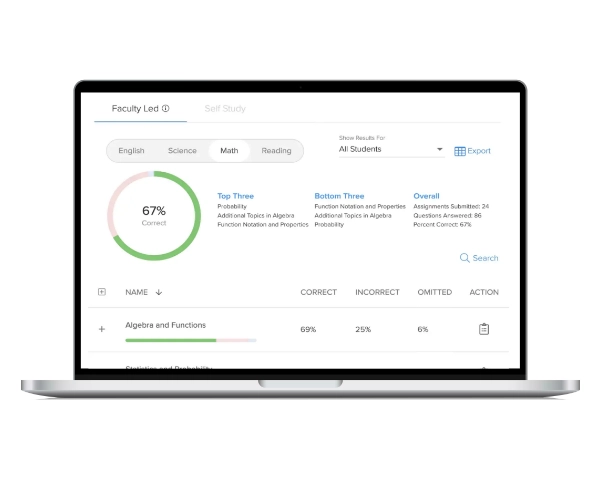Access to the AP program remains a challenge for specific demographics of students. In its 10th Annual Report to the Nation, the College Board® acknowledged the equity gap in AP course access and exam participation for underserved students, stating, “Although more underserved minority and low-income students are taking AP courses, these students remain underrepresented in AP classrooms.”
Barriers to AP courses prevent underrepresented high school students from taking advantage of AP and college education benefits. Unfortunately, the result is inequities across socioeconomic, racial, and ethnic lines regarding access to the same advanced pathway to college their middle- and upper-income and white counterparts enjoy. Some of these barriers include:
1) Access
Students attending schools in underserved communities and districts might not have the option to take AP courses even if they wanted to because their school or district may not offer an advanced program. These schools may lack adequate resources and funding to sustain standard academic programs, let alone the AP program at their institutions.
2) Costs
Costs associated with the AP program and exams can be significant for students from lower-income families. Each AP Exam costs $95 on average, and over the years, federal and state funding for AP exams has declined considerably. Even though the College Board offers a $33 fee reduction per AP Exam for eligible students (free or reduced lunch program participants), there are other costs to consider. These include textbooks, notebooks, pens, papers, a calculator, and electronic devices, to name a few.
3) Enrollment Criteria
Every school differs in its AP participation criteria; some offer open enrollment where any student who has taken prerequisite classes can enroll, while others have additional requirements such as:
- Teacher Referrals
Students may need to be recommended by a teacher to participate in an AP program. This recommendation can be beneficial because teachers are likely to know their students’ strengths and weaknesses, making it appropriate for them to identify which students are best prepared for advanced placement or make good AP candidates. - Standardized Test Scores
Other metrics used to measure students’ “AP Potential” or predict their performance in AP programs include standardized tests like the PSAT. The College Board publishes score correlations between the PSAT and potential AP Exam success for schools to vet students.
While both referrals and using data points like test scores, previous coursework, or GPAs can help predict success in advanced coursework, if used in isolation, they can easily lead to overlooking students who may indeed be capable of success. For example, the referral selection process presents the potential for implicit and unconscious bias among even the most well-intended educators.
4) Internet and Device Access
Unfortunately, the disparities in consistent and reliable Internet and device access have created a “homework gap,” defined as “school-age children lacking the connectivity they need to complete schoolwork at home.” Data from a 2015 Pew Research Center article, The numbers behind the broadband ‘homework gap’, reveals the following disparities in high-speed Internet access across US households by race and socioeconomic status:



For some students, access to reliable high-speed Internet is only half the battle; some also lack access to a device at home, e.g., a laptop or desktop computer, or have to share a single device with other household members. This lack of, or limited access to, their own devices makes it difficult for students to study consistently or complete homework.
5) Lack of Support
Research shows that “when advanced opportunities are extended to students of color. . .these students thrive alongside their peers.” But access alone is not enough. By the time Black, Latinx, English language learners, and low-income students gain access to AP in high school, they are not starting on a level playing field. That’s why, beyond fair representation in AP, these students who have not historically been part of advanced courses need extra support and dedicated attention.

Bridging the AP Equity Gap
With the factors sustaining the equity gap in AP education well-documented, here are some practical considerations toward bridging the gap that we can consider:
1) Extending AP Access to All
Making AP classes available to all willing and academically prepared students can prevent them from being overlooked for AP consideration. Adopting best practices in equity assignment, such as an Academic Acceleration policy, where districts and schools commit that their “accelerated classes look like their hallways,” could make a tremendous difference.
By refusing to turn away willing participants in AP, educators make students feel included and give them a sense of belonging in the AP experience. To bridge the equity gap in education and AP is to admit that all students deserve access.
In an article for EdWeek, AP Teacher and 2016 Washington State Teacher of the Year and National Teacher of the Year Finalist Nate Bowling offers the following concrete steps to promote equity in AP:
- Increase the number of seats in advanced classes by converting general education classes to accelerated classes. More sections mean more access for students.
- Seek out ‘non-traditional AP students’ (male students-of-color, in particular) and push them to take more rigorous classes.
- Move from “opt-in” to “opt-out” AP enrollment. The more of a hassle you make getting out, the more likely students stay in the course.
Source: When It Comes to Advanced Coursework, Equity Is Access
2) Encourage a Growth Mindset
Like all human beings, students are creatures of habit, and often, success in life depends on one’s mindset. That’s why it’s fundamental that educators create an environment wherein students can develop a growth mindset — the belief that they are more than their natural talents.
Students with a growth mindset believe that they can achieve more through productive effort, creative problem solving, good habits, and feedback from others than their latent intelligence. By assisting students in understanding that their hard work, willingness to seek help, and learning from their mistakes can propel them to the next level, educators can infuse much-needed confidence and resilience into students and encourage them to take AP courses.
3) Partner With Equity-Driven Organizations
With numerous organizations dedicated to the fight for equity in education, some of the most attainable solutions for school districts can be found in the research and recommendations put forth by such organizations. Tapping into existing data on the equity gap, including root causes, policies that sustain the status quo, best practices, and proven solutions, is an excellent step that educators can take to drive change.
Several legitimate, education-centric institutions are fighting the equity gap in education head-on and are dedicated to building equity in college readiness. Partnering with them can benefit administrators in their quest to become change agents.
4) Leverage Education Technology To Support Instruction
While education technology can be a game-changer for students, we must prioritize solving the Internet access limitations lower-income students face. Therefore, it is encouraging to see more and more school districts implementing proactive solutions to this issue. Some of these solutions include:
- one-to-one computing that allows each enrolled student to use an electronic device to access the Internet, digital course materials, and electronic textbooks, and
- providing hotspots that students can use at home.
As more schools offer such Internet and device support to their students, it enables them to use advanced technology resources such as UWorld to supplement their instruction. At UWorld, we are confident that an effective way to bridge the equity gap is by leveraging the utility of technology in education, specifically, how learning tools can help support students while saving time and effort for teachers.
Supplemental online resources such as our Learning Tools for AP® Courses can provide increased learning opportunities for all students, including those who may need a little extra support or might be taking AP for the first time. In addition, by providing such a resource to their students, administrators can ensure that students from low-income families no longer lack the tools they need to succeed in AP programs because they can’t afford to purchase them independently.
Plus, school districts that make AP resources available to students and teachers alike empower all parties by supporting in-class instruction. For example, our learning tools’ reporting functions can help teachers find knowledge gaps to remediate early on and help administrators know which students, classes, and campuses are on track or need extra support. These insights ensure that students and teachers have what they need to succeed in AP throughout the school year.
By providing students with hundreds of practice questions that emulate College Board-level content and in-depth answer explanations, our active-learning approach helps students build the stamina and perseverance to try, fail, learn from their mistakes, try again, and succeed. In our experience, as students practice more and perform better each time, their confidence increases, and their attitudes shift in the direction of believing in their capabilities.
Conclusion
We recognize that there’s no one-size-fits-all solution to bridging the equity gap in education and AP. Nonetheless, if all of us who serve in education can work together to identify these gaps, we can begin to formulate practical and sustainable solutions. Moreover, if we make it our collective mission to bridge the equity gap in education and AP, we will prioritize the needs of underserved and underrepresented students.
*Data Sources:
- National Center for Education Statistics: College Graduation Rates
- NSCRE: First-Year Persistence and Retention for Fall 2017 Cohort
- Educationdata.org: College Graduation Statistics
Learn more about UWorld’s Online Learning Tools for AP® Courses. Download our AP Brochure.




